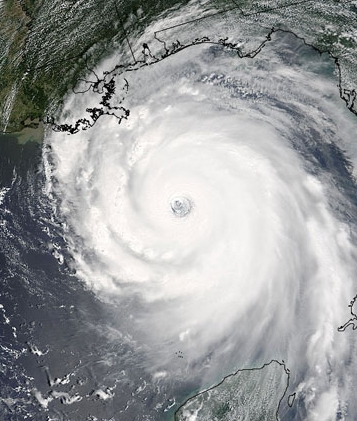Hurricanes
Feared by all who travel the seas, hurricanes are the most powerful storms that nature has to offer. Sailors throughout history and coastline settlements bordering tropical waters had to worry about being taken by surprise by such storms, until regular satellite observation of weather systems beginning in the 1970s allowed people to have advanced warning. Even with advanced weather observations, hurricanes still account for an average of $5.1 billion in damage and 20 deaths per year in the United States alone. Hurricanes average around 300 miles wide in size, but they have a huge range of sizes from under 100 miles wide to over 1000 mies wie. Hurricanes are called other things outside of the western hemisphere, such as "typhoons" in the western Pacific and just "cyclones" in the southern hemisphere, but they are all tropical cyclones that can occur in every tropical ocean and inflict major damage on places where they come ashore.
Hurricanes are classified in the western hemisphere by the Saffir-Simpson hurricane scale into five categories:

Category 1: Sustained surface winds of 75-95 mph.
Category 2: Sustained surface winds of 96-114 mph.
Category 3: Sustained surface winds of 115-130 mph.
Category 4: Sustained surface winds of 131-155 mph.
Category 5: Sustained surface winds of >155 mph.
Category 5 Hurricane Katrina churns in the Gulf of Mexico.
Image courtesy: NASA
Although all hurricanes are a significant threat to life and property, hurricanes of category 3 intensity or higher are considered "major" hurricanes, which almost always result in catastrophic damage when they make landfall, from not only wind but storm surge and inland flooding as well.
Understanding how these extremely dangerous storms work is crucial to being able to predict them better and save lives. This website explains the basic physics of how hurricanes function, and the meteorological principles behind their behavior.
Feared by all who travel the seas, hurricanes are the most powerful storms that nature has to offer. Sailors throughout history and coastline settlements bordering tropical waters had to worry about being taken by surprise by such storms, until regular satellite observation of weather systems beginning in the 1970s allowed people to have advanced warning. Even with advanced weather observations, hurricanes still account for an average of $5.1 billion in damage and 20 deaths per year in the United States alone. Hurricanes average around 300 miles wide in size, but they have a huge range of sizes from under 100 miles wide to over 1000 mies wie. Hurricanes are called other things outside of the western hemisphere, such as "typhoons" in the western Pacific and just "cyclones" in the southern hemisphere, but they are all tropical cyclones that can occur in every tropical ocean and inflict major damage on places where they come ashore.
Hurricanes are classified in the western hemisphere by the Saffir-Simpson hurricane scale into five categories:

Category 1: Sustained surface winds of 75-95 mph.
Category 2: Sustained surface winds of 96-114 mph.
Category 3: Sustained surface winds of 115-130 mph.
Category 4: Sustained surface winds of 131-155 mph.
Category 5: Sustained surface winds of >155 mph.
Category 5 Hurricane Katrina churns in the Gulf of Mexico.
Image courtesy: NASA
Although all hurricanes are a significant threat to life and property, hurricanes of category 3 intensity or higher are considered "major" hurricanes, which almost always result in catastrophic damage when they make landfall, from not only wind but storm surge and inland flooding as well.
Understanding how these extremely dangerous storms work is crucial to being able to predict them better and save lives. This website explains the basic physics of how hurricanes function, and the meteorological principles behind their behavior.